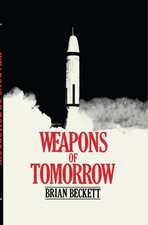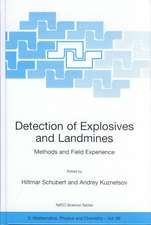The Human in Command: Exploring the Modern Military Experience
Editat de Carol McCann, Ross Pigeauen Limba Engleză Hardback – 30 iun 2000
| Toate formatele și edițiile | Preț | Express |
|---|---|---|
| Paperback (1) | 1662.07 lei 6-8 săpt. | |
| Springer Us – 8 oct 2012 | 1662.07 lei 6-8 săpt. | |
| Hardback (1) | 1700.55 lei 6-8 săpt. | |
| Springer Us – 30 iun 2000 | 1700.55 lei 6-8 săpt. |
Preț: 1700.55 lei
Preț vechi: 2073.83 lei
-18% Nou
Puncte Express: 2551
Preț estimativ în valută:
325.39€ • 340.65$ • 269.25£
325.39€ • 340.65$ • 269.25£
Carte tipărită la comandă
Livrare economică 05-19 aprilie
Preluare comenzi: 021 569.72.76
Specificații
ISBN-13: 9780306463662
ISBN-10: 0306463660
Pagini: 441
Ilustrații: XIII, 441 p.
Dimensiuni: 155 x 235 x 30 mm
Greutate: 1.8 kg
Ediția:2000
Editura: Springer Us
Colecția Springer
Locul publicării:New York, NY, United States
ISBN-10: 0306463660
Pagini: 441
Ilustrații: XIII, 441 p.
Dimensiuni: 155 x 235 x 30 mm
Greutate: 1.8 kg
Ediția:2000
Editura: Springer Us
Colecția Springer
Locul publicării:New York, NY, United States
Public țintă
ResearchDescriere
MAJOR-GENERAL M. K. JEFFERY Command, and mdeed the human in command, has always been key to milItary operations. The complexIty and tempo of modern operations make this statement even more true today than in the past. However, both the military and the research 2 communities have tended to treat command and control (C ) from a limited per spective. For too long, command and control have been considered as if they were a single concept, with control often dominatmg our study. Indeed, in many 2 cases we have divorced operational C from the military institution itself, resulting in disconnects and inefficiencies. Then, in an attempt to overcome these self-inflicted deficiencies, we have pursued the Holy Grail of technology, hoping that it 2 would solve our C problems. Only now, as we start to realize technology's costs 2 and limitations, are we looking critically at C • This book attempts to take such a look. The contributions that make up this book are the product of a June 1998 NATO (North Atlantic Treaty Organization) workshop called The Human m Command. Far from being purely an academIc exercise, this gathenng brought together milI 2 tary leaders and civilian scientists to discuss C's central pragmatic and conceptual issues-its assumptions, its practices, and its organization. Indeed, in recent years there has been mounting evidence that both our society and Its military institutions are facing organizational crises.
Cuprins
Foreword; M.K. Jeffery. Acknowledgments. 1. The Human in Command: A Brief Introduction; R. Pigeau, C. McCann. Part I: The Command Experience. 2. The Nature of Command; R.R. Crabbe. 3. The Human in Command: A Personal View; S. Cherrie. 4. Command Experiences in Rwanda; R.A. Dallaire. 5. The Fog of War: A Personal Experience of Leadership; R.A. Lane. 6. Command and Control in Stressful Conditions; P.L.E.M. Everts. 7. Command and Leadership in Other People's Wars; M.D. Capstick. 8. Establishing Command Intent - A Case Study: The Encirclement of the Ruhr, March 1945; W.M. Connor. 9. Time, Tempo, and Command; J.S. Labbé. 10. United States Army Leadership Doctrine for the Twenty-First Century; J.P. Lewis, et al. 11. Human Problems in Organizational Devolution; J. Penrose. Part II: The Science of Command. 12. Redefining Command and Control; R. Pigeau, C. McCann. 13. Developing Practical Thinking for Battle Command; J.J. Fallesen. 14. Command and Control: A Biased Combination? P.-A. Persoon, et al. 15. Mission Command in Ambiguous Situations; A.L.W. Vogelaar, E.-H. Kramer. 16. Dynamic Decision Making in Command and Control; B. Brehmer. 17. Self-Assessment of Command Performance and Feedback in Multiforce Training; A. Mirabella, et al. 18. A Schema-Based Approach to Measuring Team Decision Making in a Navy Combat Information Center; C. Paris, et al.19. Communication of Intent in Military Command and Control Systems; G. Shattuck, D.D. Woods. 20. Misplaced Loyalties: Military Culture and the Breakdown of Discipline in Two Peace Operations; D. Winslow. 21. Morale, Cohesion, and Confidence in Leadership: Unit Climate Dimensions for Canadian Soldiers on Operations; P.J. Murphy, K.M.J. Farley. 22. Coping with Interrogations; J.C. Laberg, et al. 23. Stressors Faced by Commanders in Three Operational Environments: The Gulf, Bosnia, and Northern Ireland; G.M. Breakwell. 24. Training of Higher-Level Joint Commanders; C. Jeffery, et al. 25. Relative Efficacy of an Open versus a Restricted Communication Structure for Command and Control Decision Making: An Experimental Study; M. Omodei, et al. 26. Research Challenges for the Human in Command; C. McCann, R. Pigeau. The Contributors. Index.
Recenzii
"The Human in Command represents an original and important contribution to the literature on command. For military practioners it should be required reading on senior command courses, but there is also much here for the non-military reader. Commanders in emergency services and other professions, as well as those conducting research into command and leadership, will find this to be a valuable reference and an excellent source of military material."
(Journal of Contingencies and Crisis Management, 9:2 (2001)
(Journal of Contingencies and Crisis Management, 9:2 (2001)


















